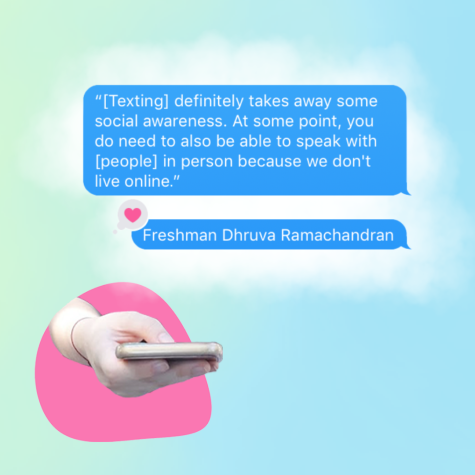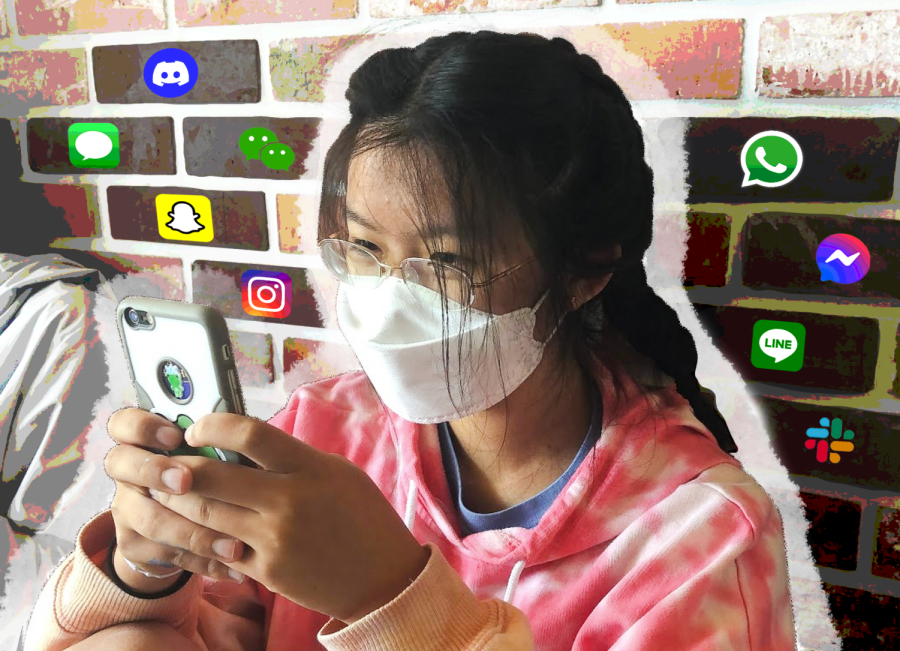Connected through texting
Exploring the benefits and drawbacks of digital communication
Photo illustration by Kalyani Puthenpurayil
Like Sophomore Esther Suh, many individuals utilize messaging platforms to connect with others for reasons ranging from talking to friends and family to work related purposes.
“LOLLL.”
Sophomore Esther Suh sends this short message, responding to a hilarious remark from a friend. Yet the extreme enthusiasm that she displays by adding capital “L”s to the “laugh out loud” acronym does not accurately reflect the bland expression on her face that remains hidden behind her phone screen.
For Suh, not having to worry about her tone or appearance is a convenience that comes with texting, along with not having to respond to a message right away. She also enjoys having the internet at her fingertips in case she wants to search something up when having debates with her friends.
“[After] you talk in-person, the conversation just stops,” Suh said. “Texting is something [you can] come back to later [because] everybody can [look at] what we were talking about before. [When you’re] in-person, you’ll probably forget about the whole thing whereas texting gives you more time to think — it’s more convenient.”

Freshman Dhruva Ramachandran also views texting as an easier mode of communication, as he can virtually connect with people whenever and wherever he wants to. During the pandemic, Ramachandran frequently found himself texting his friends to communicate with them. In turn, the familiar visits to his friends’ houses and the conversations he had with them at school quickly dissolved into something of the past.
He also finds that his time at home helped him form more connections that he wouldn’t have been able to build if he attended school in-person. For Ramachandran, the lack of the physical presence of his friends propelled him to step out of his bubble and converse with more people by connecting with mutual friends.
Erica Pelavin, an adolescent psychologist and co-founder of My Digital Tat2, finds that texting is “an amazing way to stay connected.” My Digital Tat2 presents the idea that anything an individual puts on the internet is similar to a tattoo — “it may fade but it never goes away.” As part of her organization, she works towards helping young people navigate technology responsibly and helps older people recognize the “power in a connected world [through technology]” in order to be more involved in their children’s digital lives.
Pelavin finds that while texting allows for communication, it also has some inevitable downsides. For example, the ambiguity created by the lack of physical cues, such as tone, eye contact and emotion can lead to people creating “bad narratives when [they] don’t know what the circumstances are like.”
“People define emojis differently [and], particularly with autocorrect, there can be miscommunication,” Pelavin said. “You have to know the nuances of capital letters and punctuation. I also think sometimes people can become more mean on text because they don’t see the reaction of the person on the other side of the screen.”
Reflecting on her own childhood, Pelavin shares that communication between teens has changed due to the decrease of adult presence in communication. When she was younger, her parents would be able to listen in on her phone conversations due to a shared landline in the house. Additionally, when she and her friends wanted to hang out with each other, they would have to go up to each other’s houses and ring the doorbell to ask their parents for permission.

“An adult would answer the telephone and you’d have to say, ‘Excuse me, can I please talk to Erica?’ and then they’d say ‘Who’s calling?’ and you’d have to have a short conversation with the adult so there was more of a screening process,” Pelavin said. “Now I notice [that] when I pick up my kids, they’ll just say ‘I’m here’ and that means I’m supposed to go out with them.”
With both the benefits and drawbacks, Suh, Pelavin and Ramachandran agree that there must be a balance in talking with people both virtually and face-to-face.
“[Texting] definitely takes away some social awareness,” Ramachandran said. “At some point, you do need to also be able to speak with [people] in person because we don’t live online. Over COVID, a lot of people were just texting and now they don’t know how to [talk] in person.”









